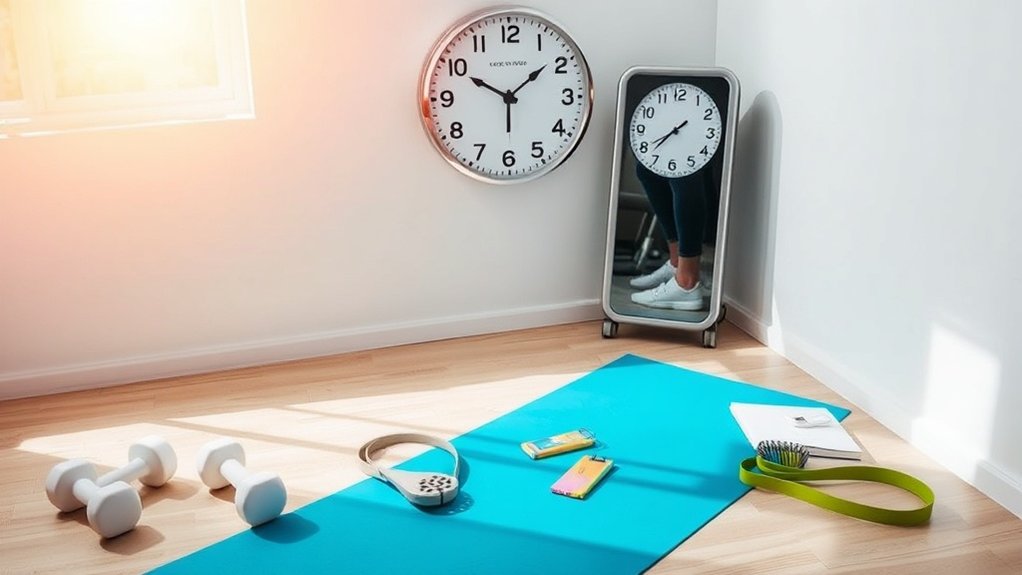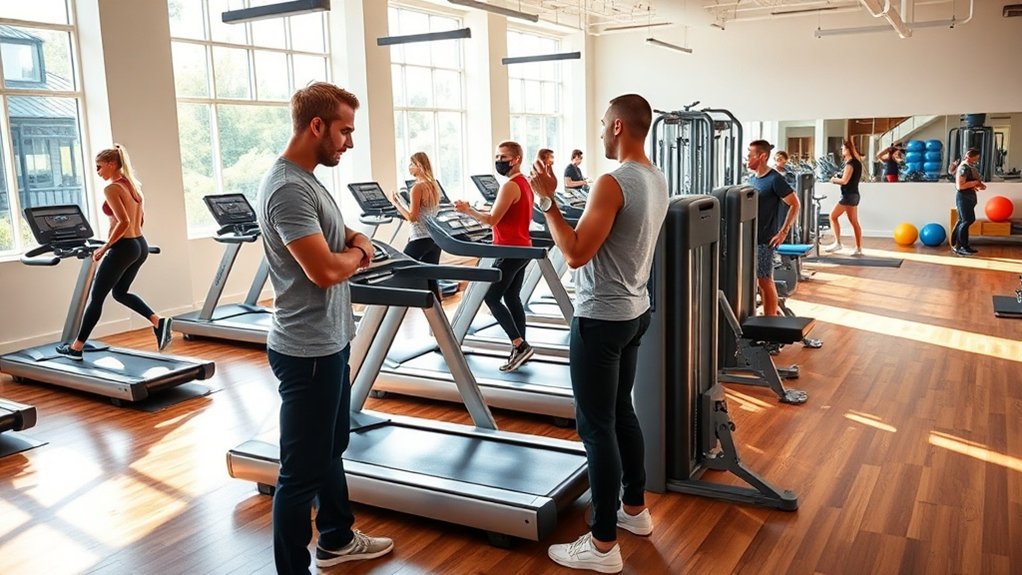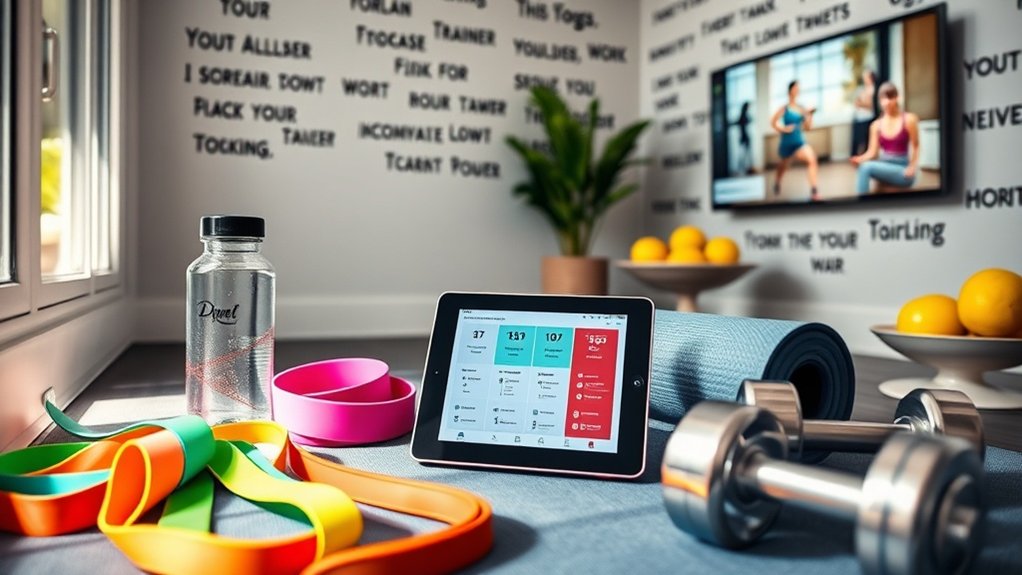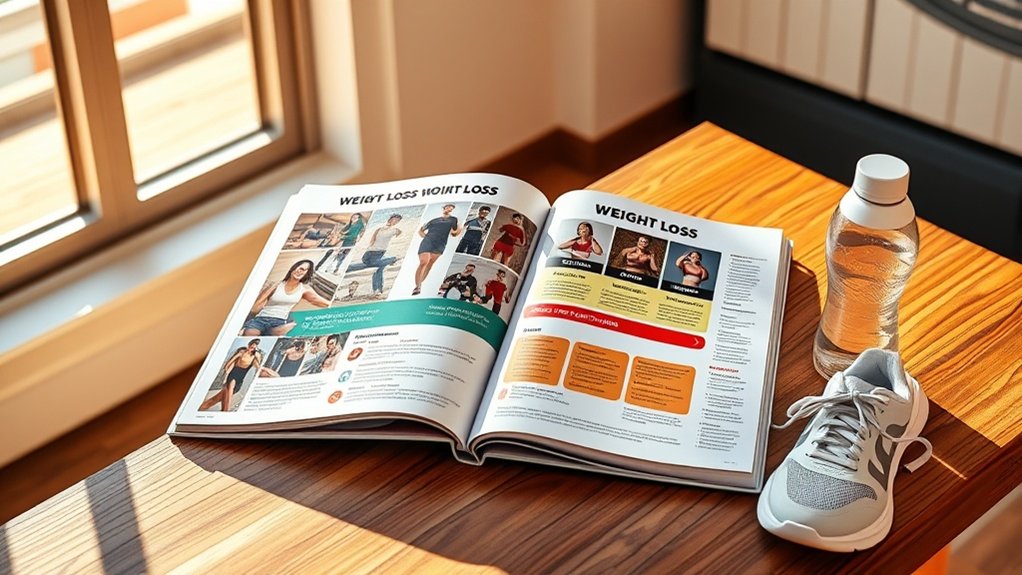Start your fitness journey by evaluating your baseline through simple tests like a one-mile run and push-up count, then set SMART goals targeting 150 minutes of weekly moderate activity. You’ll build your foundation by mastering six fundamental movement patterns—push, pull, squat, lunge, hinge, and core stabilization—through compound exercises. Begin with 3-4 weekly strength sessions at 50-70% of your one-rep max, prioritizing proper form over weight. Track your progress every six weeks, and you’ll uncover the complete framework for sustainable fitness transformation ahead.
Assessing Your Fitness Level and Setting Realistic Goals

Starting a workout program without knowing your baseline fitness level is like driving without a map—you won’t know if you’re making progress or heading in the right direction.
Begin by evaluating your fitness level through simple tests: time a one-mile run and count your push-ups. These measurements establish your starting point.
Next, apply the SMART goal framework to create realistic goals. Your fitness objectives should be Specific, Measurable, Attainable, Relevant, and Timely.
Consider your available time for exercise—aim for 150 minutes of moderate activity weekly. Set short-term goals like improving your mile time, which builds momentum toward long-term fitness success.
Track your progress by re-evaluating every six weeks. This data-driven approach keeps you motivated and allows necessary adjustments to your plan.
Understanding Fundamental Movement Patterns and Exercise Selection
You’ll build a stronger foundation by mastering six fundamental movement patterns: push, pull, squat, lunge, hinge, and core stabilization.
Research shows that focusing on these patterns through compound exercises like squats and deadlifts activates multiple muscle groups simultaneously, delivering superior strength gains and calorie burn compared to isolation movements.
Basic Movement Patterns Explained
Before you plunge into creating your workout routine, you need to understand the six fundamental movement patterns that form the foundation of human strength and mobility: push, pull, squat, lunge, hinge, and core.
These basic movement patterns guarantee you’re developing all major muscle groups systematically rather than randomly.
Compound exercises built on these patterns engage multiple joints simultaneously, maximizing your workout efficiency regardless of your fitness levels.
When you master squats, you’re not just building leg strength—you’re developing coordination, stability, and functional fitness that translates directly to daily activities like climbing stairs or lifting groceries.
This systematic approach to training provides critical injury prevention benefits.
Choosing Effective Beginner Exercises
Each exercise you select should directly map to one of the fundamental movement patterns you’ve learned, creating a balanced framework that develops your entire body.
When choosing effective beginner exercises, prioritize bodyweight exercises like push-ups and squats that require no equipment while building strength across major muscle groups. Compound movements deliver exceptional efficiency by engaging multiple muscles simultaneously, accelerating your results and supporting functional fitness for everyday activities.
Your workout routine must align with your specific fitness goals while remaining enjoyable enough to maintain long-term.
Start with manageable variations of each movement pattern, then implement gradual progression as your strength improves. This systematic approach guarantees you’re building coordination and capacity without overwhelming your body, creating sustainable momentum throughout your fitness journey.
Mastering Proper Form and Determining Your Starting Weights

The foundation of any successful fitness journey rests on two critical pillars: mastering proper form and selecting appropriate starting weights. For beginners, proper technique prevents injuries while maximizing muscle engagement during strength training.
Essential form principles you’ll need to master:
- Maintain upright posture with engaged core throughout each movement.
- Execute controlled motions through full range of motion, using mirrors or video recordings to verify alignment.
- Implement proper warm-up and cool-down routines, including dynamic stretching before and static stretching after workouts.
To determine your starting weights, perform test sets of 8-12 repetitions until fatigued while maintaining form.
Begin with 50-70% of your one-repetition maximum, focusing on technique before progressively increasing resistance. This evidence-based approach guarantees sustainable progress throughout your fitness journey.
Building Your First-Month Workout Program and Schedule
Once you’ve mastered proper form and identified your baseline strength levels, you’ll construct a strategic first-month program that balances intensity with muscle recovery.
Target 3-4 strength training sessions weekly, emphasizing compound movements like squats and push-ups that engage multiple muscle groups simultaneously. Distribute 150 minutes of moderate cardio activity throughout your week to build cardiovascular endurance.
Begin each session with a 5-10 minute dynamic warm-up to prepare your joints and muscles, then conclude with static stretching held for 15-30 seconds.
Maintain a workout journal documenting weights, repetitions, and personal achievements—this data-driven approach helps you track progress relative to your fitness level and make evidence-based adjustments.
Your journal becomes your roadmap, revealing patterns and celebrating milestones that fuel continued commitment.
Directing the Gym: Equipment Familiarization and Gym Etiquette

Walking into a gym for the first time can feel overwhelming, but understanding the equipment and social dynamics will transform your anxiety into confidence.
You’ll need to master the basics of resistance machines, free weights, and cardio equipment while simultaneously learning the unwritten rules that keep the gym environment respectful and efficient.
Research shows that beginners who invest time in proper equipment familiarization and etiquette adherence are 40% more likely to maintain consistent gym attendance beyond three months.
Mastering Essential Gym Equipment
Before you can build strength and confidence in your fitness journey, you’ll need to master the fundamental equipment that forms the backbone of any effective gym workout.
A fitness professional can guide you through proper form and technique, helping you build muscular fitness while improving body composition.
Focus on mastering essential gym equipment through these core stations:
- Treadmills: Control your cardio intensity with adjustable speed and incline settings for effective cardiovascular conditioning.
- Weight machines: Target specific muscle groups with guided movements that guarantee proper form and technique during exercises for beginners.
- Free weights: Develop functional strength through compound movements that engage multiple muscle groups simultaneously.
Your workout plan becomes exponentially more effective when you understand each machine’s resistance adjustments and safety features, preventing injuries while maximizing results.
Unwritten Rules to Follow
Mastering equipment mechanics means nothing if you shake the shared gym environment through poor etiquette. Your gym workout success depends on respecting communal fitness spaces.
Always sanitize machines after each use—this simple physical activity protects everyone’s health. During peak time, limit your routine to 20-30 minutes per machine, allowing others to progress through their workout program.
Maintain adequate distance from fellow members during their exercises; interrupting their muscle gain efforts breaks concentration and risks injury. When you’re uncertain about proper form or equipment operation, seek guidance from certified trainers rather than attempting dangerous movements alone.
These unwritten gym etiquette rules aren’t just courtesy—they’re essential protocols that create safe, productive environments where everyone’s fitness goals can flourish without unnecessary conflict or delays.
Recognizing Progress, Avoiding Common Mistakes, and When to Advance
As you progress through your beginner workout plan, you’ll need objective markers to gauge your advancement and guarantee you’re building fitness safely. Recognizing progress involves measuring your progress every six weeks—track strength gains, endurance improvements, and body measurements to maintain motivation and optimize your workout routine for maximum health benefits.
Avoid these common mistakes that undermine results:
- Skipping warm-ups, cool-downs, and recovery periods, which increases injury risk
- Neglecting rest days, leading to overtraining and muscle burnout
- Increasing the intensity too rapidly, causing setbacks instead of sustainable gains
Listen to your body—pain beyond normal muscle soreness signals needed rest. When you’re completing routines with proper form and minimal fatigue, gradually increase the intensity.
Celebrate small victories like finishing challenging sets, as these milestones fuel long-term commitment.
Frequently Asked Questions
How to Create a Personalized Fitness Plan for Beginners?
You’ll create your personalized plan through SMART goal setting, diverse exercise selection, and progress tracking. Incorporate nutrition basics, recovery strategies, and motivation techniques while maintaining workout consistency. Use reliable fitness resources to optimize your journey and achieve measurable results.
What Is the 3-3-3 Rule for Workout?
The 3-3-3 rule is your fitness roadmap: you’ll complete three sets of three exercises targeting different muscle groups. This workout frequency optimizes exercise duration, intensity levels, and recovery time while building fitness consistency through strategic goal setting and progress tracking.
How to Start Your Fitness Journey for Beginners?
Set SMART fitness goals and start with beginner workouts 2-3 times weekly. Prioritize workout consistency, learn nutrition basics, and focus on injury prevention through proper form. Balance exercise motivation with mental health needs while managing time effectively.
What Is the Best Fitness Plan for Beginners?
You’ll transform your physique by combining beginner fitness elements: 150 minutes of cardio options weekly, strength training twice, flexibility exercises, and nutrition basics. Set SMART goals, use effective workouts progressively, and apply motivation tips for sustainable results.



